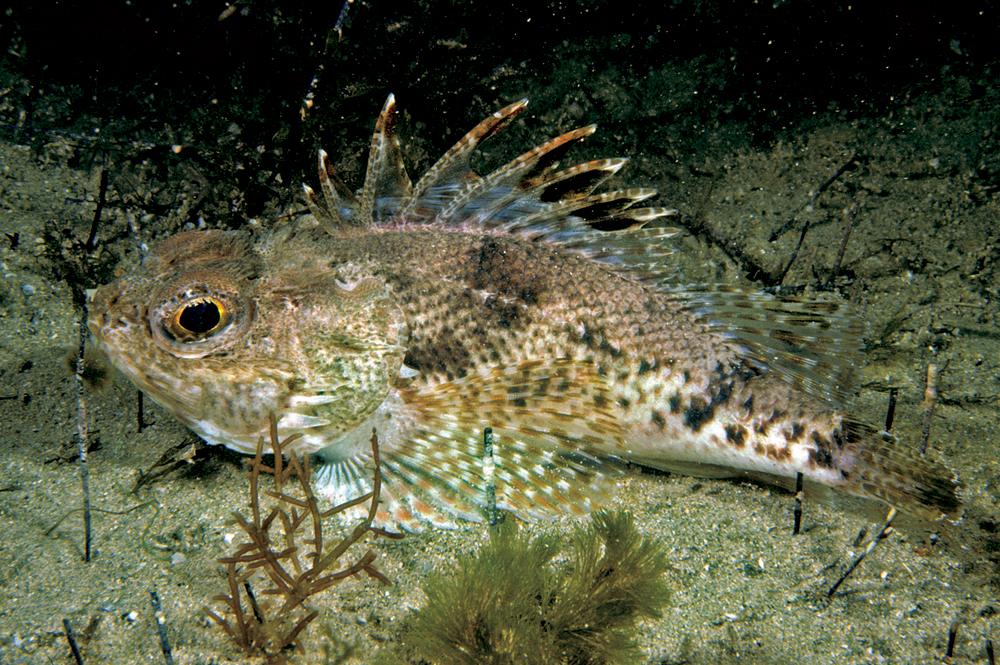Southern Gurnard Perch, Maxillicosta meridianus Motomura, Last & Gomon 2006
Other Names: Southern Gurnard Perch

Southern Gurnard Perch, Maxillicosta meridianus. Source: Rudie H. Kuiter / Aquatic Photographics. License: All rights reserved
Summary:
A small brownish gurnard perch mottled with three dark reddish-brown blotches and three indistinct oblique dark brown to blackish saddles, a prominent black blotch on the rear of the spinous dorsal fin, and a whitish caudal fin often with pale brown or grey spots that do not form bands.
The Southern Gurnard Perch usually occurs in deeper waters than the similar Little Gurnard Perch, Maxillicosta scabriceps.
The Southern Gurnard Perch usually occurs in deeper waters than the similar Little Gurnard Perch, Maxillicosta scabriceps.
Cite this page as:
Bray, D.J. 2018, Maxillicosta meridianus in Fishes of Australia, accessed 02 Jul 2025, https://fishesofaustralia.net.au/Home/species/4053
Southern Gurnard Perch, Maxillicosta meridianus Motomura, Last & Gomon 2006
More Info
|
Distribution |
Endemic to southern Australia, from off Port Albert, Victoria, to Flinders Island, South Australia, including northern Tasmania. The species is not known from shallow Victorian coastal waters east of about Cape Otway. Inhabits sandy bottoms in depths to 137 m, preferring deeper sand channels away from rubble and seagrass areas. The Southern Gurnard Perch is nocturnal, and may lie completely buried in sand during the day, before coming out to feed at night. |
|
Features |
D XIII, 7 A III, 5 C 10–12 P 21–24 V I, 5 LL 27–29 GR 3-4 + 7–9 = 10–12 Nasal bone on each side with 5-10 spines; supraocular ridge with 18-39 close-set, weakly developed spines; interorbital relatively shallow, depth 2.5–3.3 times in width. .Pectoral fin 21-24; Scales in longitudinal series 47-51; Lateral-line scales (pored) 27-29; Scale rows between bases of last pelvic-fin rays 3-4; Scales above lateral line 2-3, below lateral line 12-14; Scales between lateral line and base of sixth dorsal-fin spine 3-5; Scales between lateral line and last dorsal-fin spine 4-5. Scales above lateral line behind head usually with no strong median ridge; central portion of inner ridge on ventral mandibular surface at the inner edge of dentary or closer to inner edge than to central ridge, no short ridge between posterior portions of inner and central ridges; anterior margin of nasal spine with 0-6 spinous points, number decreasing with growth, spinous points 5-15 on entire nasal spine; surface of preocular spine with 5-13 spinous points; spines or distinct ridges absent on lateral margin of occipital pit between tympanic spine and origin of parietal spine base; ossified scale behind front edge of occipital pit between tympanic spines absent; dorsal surface of occipital pit smooth, no spines; spinous points 2 (rarely 1 or 3) at tip of upper opercular spine; posterior margin of maxilla extending slightly beyond a vertical through posterior margin of pupil; snout length 7.9-9.6 (8.6)% SL, upper-jaw length 19.1-22.2 (20.3)% SL, first anal-fin spine length 11.6-14.4 (13.1)% SL, second anal-fin spine length 18.4-22.5 (20.5)% SL, third anal-fin spine length 13.4-16.2 (14.7)% SL, and caudal-peduncle depth 7.8-9.0 (8.6)% SL. |
|
Colour |
Upper surface brownish, mottled with dark reddish brown blotches and with 3 poorly defined oblique dark brown or blackish saddles; spinous portion of dorsal fin with prominent black blotch between 5th and 9th spines. |
|
Similar Species |
Maxillicosta meridanalis usually occurs in deeper waters than the similar Little Gurnard Perch, M. scabriceps. Although the Southern Gurnard Perch tends to be paler in colour than the Little Gurnard Perch, colour pattern intensity is variable, making it unsuitable as a diagnostic character. |
|
Etymology |
The specific name meridianus is derived from the Latin for ‘‘southern,’’ in reference to the southern distribution of the species, relative to that of M. whitleyi, with which it has been confused. |
|
Species Citation |
Maxillicosta meridianus Motomura, Last & Gomon 2006, Copeia 2006(3): 446, figs 1, 2A-B, 3A, 4A, 5, 6, 7A, 9. Type locality: Bass Strait, TAS, 10-20m [39°27'S, 148°21'E]. |
|
Author |
Bray, D.J. 2018 |
|
Resources |
Southern Gurnard Perch, Maxillicosta meridianus Motomura, Last & Gomon 2006
References
Johnson, J.W. & Motomura, H. 2008. Family Neosebastidae. pp. 489-495 in Gomon, M.F., Bray, D.J. & Kuiter, R.H. (eds). Fishes of Australia's Southern Coast. Sydney : Reed New Holland 928 pp.
Motomura, H., Last, P.R. & Gomon, M.F. 2006. A new species of the scorpionfish genus Maxillicosta from the southeast coast of Australia, with a redescription of M. whitleyi (Scorpaeniformes: Neosebastidae). Copeia 2006(3): 445-459
Poss, S.G. 1994. Family Scorpaenidae. pp. 477-494 figs 428-441 in Gomon, M.F., Glover, C.J.M. & Kuiter, R.H. (eds). The Fishes of Australia's South Coast. Adelaide : State Printer 992 pp. 810 figs. (as Maxillicosta whitleyi)




